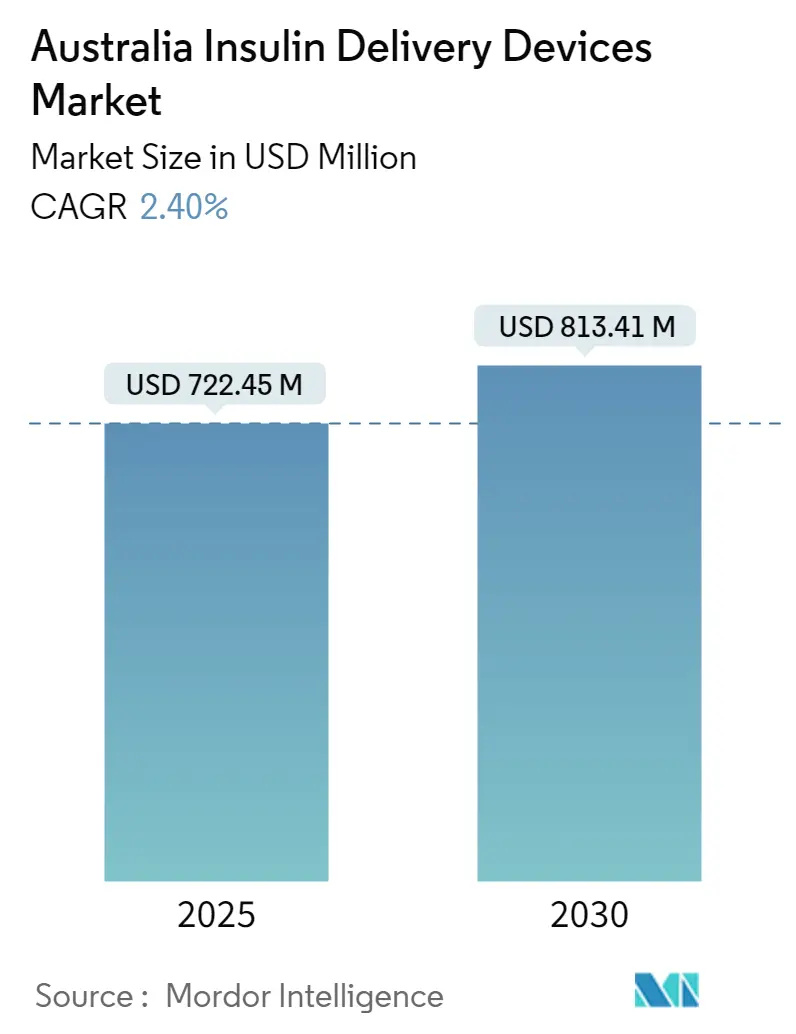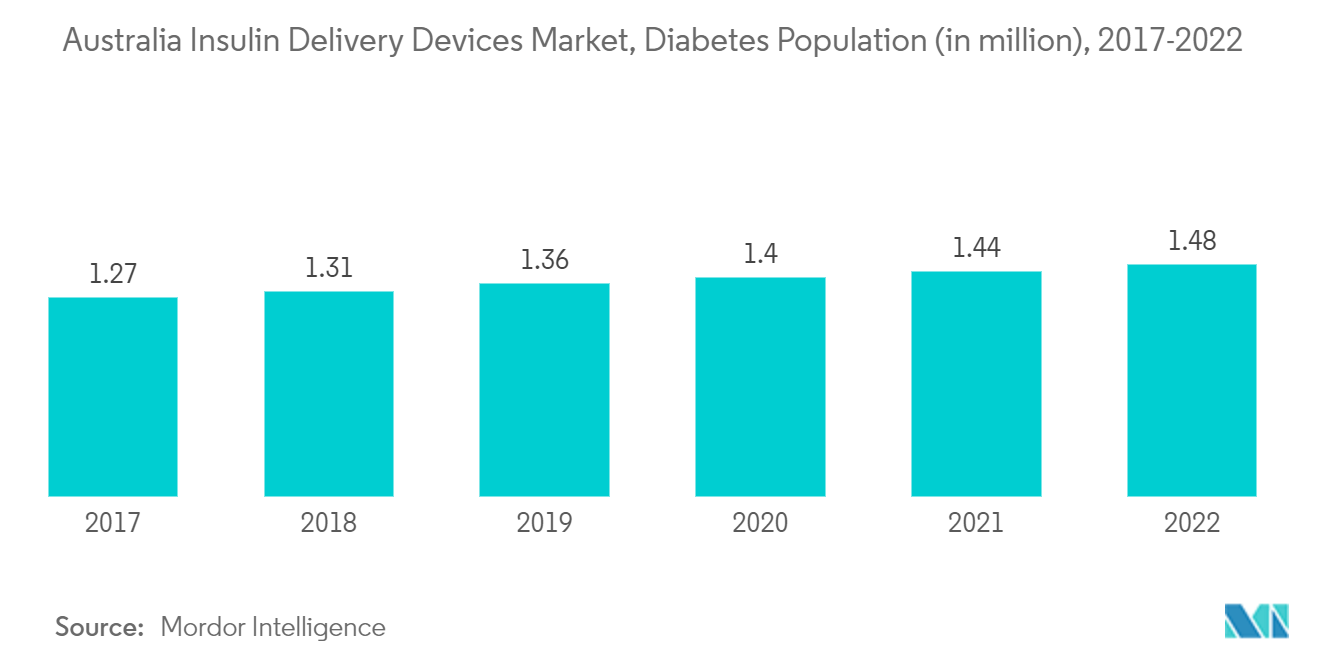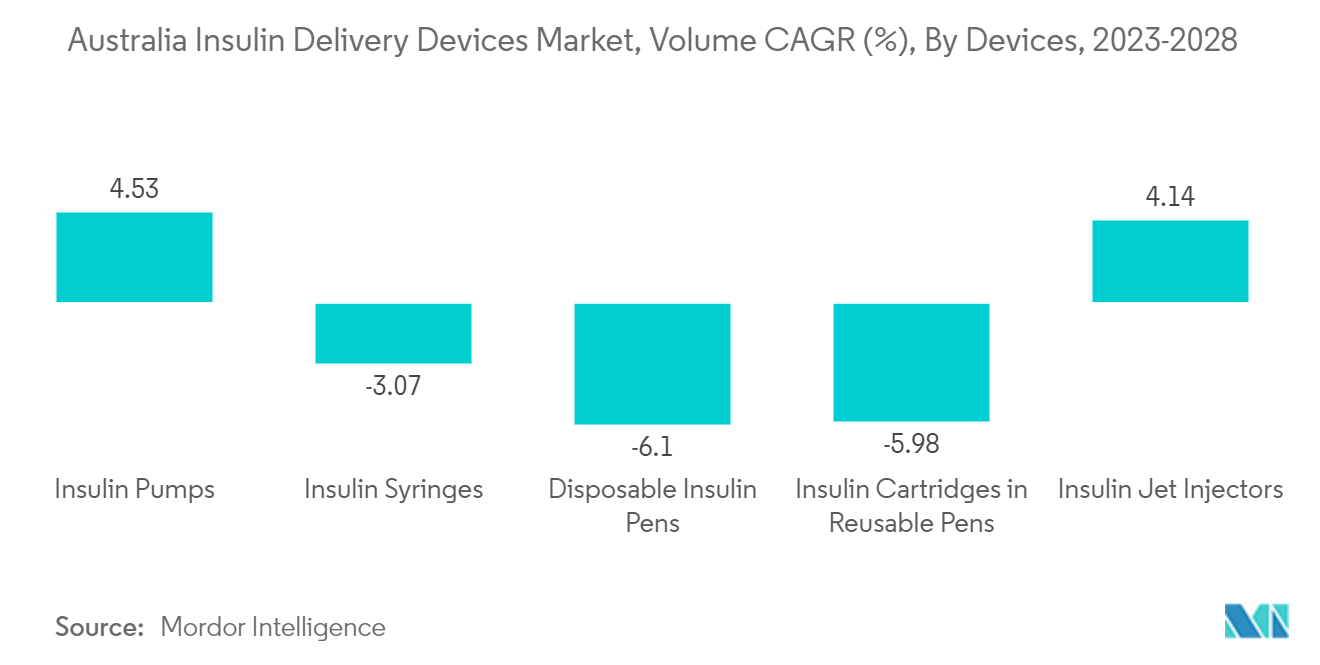Australia Insulin Delivery Devices Market Analysis
The Australia Insulin Delivery Devices Market size is estimated at USD 722.45 million in 2025, and is expected to reach USD 813.41 million by 2030, at a CAGR of 2.4% during the forecast period (2025-2030).
During the COVID-19 pandemic, patients with diabetes were at higher risk for hospitalizations and complications due to hyper- or hypoglycemia, metabolic comorbidities, and more severe illness from SARS-CoV-2 infection. Throughout the COVID-19 pandemic, the effects of diabetes worsened with infection and infection-induced new-onset diabetes in both adults and children. Diabetes self-management, follow-up care, and glycemic management were disrupted during the COVID-19 pandemic, which recognized the need for proper guidelines and protocols to ensure successful continuity of management and follow-up care for people with existing and new-onset diabetes.
Diabetes is a chronic condition characterized by high blood glucose levels caused by the inability to produce insulin or use insulin effectively, or both. The main types of diabetes are type 1 diabetes and type 2 diabetes. For a patient with type 1 diabetes, insulin therapy is important for replacing the insulin the body doesn't produce. People with type 2 diabetes or gestational diabetes need insulin therapy if other treatments, such as diabetes medications and other lifestyle changes, cannot keep blood glucose levels within the desired range. Diabetes treatment aims to maintain healthy blood glucose levels to prevent short- and long-term complications, such as cardiovascular disease, kidney disease, blindness, and lower limb amputation.
Diabetes has a significant and often preventable impact on the health and well-being of the Australian population. The Australian Government reviews processes and infrastructure to ensure adequate supplies and supply chains of essential medications, glucose monitoring equipment, insulin pump consumables, and measures to manage diabetes. People with diabetes who have disabilities require specialized assistance managing their diabetes, including accessing health services, administering insulin, and operating diabetes devices.
The overall CAGR is impacted by consumers switching from insulin pens and syringes to insulin pumps due to increased efficacy and patient compliance.
Australia Insulin Delivery Devices Market Trends
Rising Diabetes Prevalence in Australia
According to Diabetes Australia, diabetes is the fastest-growing chronic condition in Australia, increasing faster than other chronic diseases such as heart disease and cancer.
Currently, almost 1.9 million Australians have diabetes, including all types of diagnosed diabetes (almost 1.5 million known and registered) and undiagnosed type 2 diabetes (up to 500,000 estimated). The incidence of diabetes in children and young people is increasing. Almost all children and young people with diabetes have type 1 diabetes. In addition, children develop type 2 diabetes at younger ages. Children and young people with type 1 and type 2 diabetes have specific needs, such as access to care from a multidisciplinary pediatric diabetes team and to diabetes treatments and supporting technologies.
Around 1.2 million people are hospitalized with diabetes-related conditions every year. Aboriginal and Torres Strait Islander Australians are three times more likely to develop type 2 diabetes than non-Indigenous Australians, 4.3 times more likely to be hospitalized with type 2 diabetes, and four times as likely to die. Various evidence suggests that diabetes can be successfully managed, especially when detected early. Multifactorial intervention, including control of blood glucose, blood pressure, and lipids, can reduce the range of diabetes-related microvascular and macrovascular complications and premature mortality.
Australian Commission on Safety and Quality in Health Care clinical care standards program plays an important role in delivering appropriate care and reducing unwarranted variation, as they identify and define the care people should be offered or receive, regardless of where they are treated. The National Association of Diabetes Centre has developed diabetes care standards and an accreditation process that can help to make diabetes care nationally consistent.
Therefore, the studied market is anticipated to grow over the analysis period due to rising prevalence and the factors above.
The Insulin Pumps Segment is Expected to Witness the Highest Growth Rate Over the Forecast Period
Insulin Pump is expected to register a CAGR of more than 4.5% in the market during the forecast period because of the increasing technological advancement and its preference over other traditional methods due to continuous insulin administration.
An insulin pump is a small battery-operated electronic device about the size of a pager or small mobile phone. The rapid-acting insulin is delivered via an infusion set inserted under the skin, i.e., subcutaneously. The device delivers insulin in two ways, basal (delivering small amounts of insulin continuously to maintain cell function) and bolus (delivering a dose of insulin on demand to account for the carbohydrates in meals or to correct high blood glucose levels). An insulin pump is worn 24 hours a day but can be taken off for up to two hours when required.
Data can be uploaded from insulin pumps via web-based software. The data relating to glucose concentrations and insulin delivery can be reviewed by the health professional with the patient. Randomized controlled trials have reported improved glycemic control using insulin pump therapy compared to multiple daily injections. These include reductions in blood glucose, hypoglycemia, lower glycated hemoglobin, lower insulin requirements, and improved quality of life. Type-1 diabetic patients must check their blood glucose levels regularly, monitor their blood glucose levels, and adjust the insulin dosing to maintain optimum glucose levels.
The Australian Government is maintaining access to affordable, high-quality medicines, devices, and services to support people with diabetes in self-management and treatment. It supports people with diabetes through the National Diabetes Services Scheme, the Pharmaceutical Benefits Scheme, the Insulin Pump Program, and Medicare and other funding. Insulin pump consumables (infusion sets and reservoirs/cartridges) are subsidized by the NDSS for eligible consumers only. Under the NDSS, the cost of an infusion set is currently about $1.60. The cost of an insulin reservoir/cartridge is about $1 per unit.
The factors above are likely to drive segment growth during the forecast period.
Australia Insulin Delivery Devices Industry Overview
The Australia Insulin Delivery Devices Market is consolidated, with few significant players. The major players such as Insulet Corporation, Ypsomed, and Novo Nordisk are working on innovations in insulin devices which is evident from the companies spending on research and developments to strengthen their market presence further.
Australia Insulin Delivery Devices Market Leaders
-
Insulet Corporation
-
Ypsomed
-
Novo Nordisk A/S
-
Medtronic
-
Eli Lilly and Company
- *Disclaimer: Major Players sorted in no particular order
Australia Insulin Delivery Devices Market News
- November 2022: Eli Lilly and Company announced that it would roll out its first connected platform, the Tempo Personalized Diabetes Management Platform. The technology aims to help adults with type 1, or 2 diabetes and clinicians make informed, data-backed decisions to manage treatment with Lilly insulins. The platform consists of three key components - the Tempo Smart Button; a compatible app, TempoSmart; and a prefilled insulin pen, Tempo Pen- which deliver personalized guidance for adults with diabetes.
- August 2022: Ypsomed launched bolus delivery from the smartphone on the mylife YpsoPump via the mylife App. This new feature enables mylife YpsoPump users to deliver the bolus insulin conveniently and discreetly via their smartphone without interacting with the pump itself.
Australia Insulin Delivery Devices Industry Segmentation
There are different ways to inject insulin into a patient's body, using syringes, pens, pumps, and jet injectors, giving them various options for insulin delivery. The Australia Insulin Delivery Devices Market is segmented into insulin pumps, insulin syringes, disposable insulin pens, insulin cartridges in reusable pens, and insulin jet injectors. The report offers the value (in USD million) and volume (in Units million) for the above segments.
| Insulin Pumps | Insulin Pump Devices |
| Insulin Pump Reservoirs | |
| Insulin Infusion sets | |
| Insulin Pens | Cartridges in reusable pens |
| Disposable insulin pens |
Australia Insulin Delivery Devices Market Research FAQs
How big is the Australia Insulin Delivery Devices Market?
The Australia Insulin Delivery Devices Market size is expected to reach USD 722.45 million in 2025 and grow at a CAGR of 2.40% to reach USD 813.41 million by 2030.
What is the current Australia Insulin Delivery Devices Market size?
In 2025, the Australia Insulin Delivery Devices Market size is expected to reach USD 722.45 million.
Who are the key players in Australia Insulin Delivery Devices Market?
Insulet Corporation, Ypsomed, Novo Nordisk A/S, Medtronic and Eli Lilly and Company are the major companies operating in the Australia Insulin Delivery Devices Market.
What years does this Australia Insulin Delivery Devices Market cover, and what was the market size in 2024?
In 2024, the Australia Insulin Delivery Devices Market size was estimated at USD 705.11 million. The report covers the Australia Insulin Delivery Devices Market historical market size for years: 2019, 2020, 2021, 2022, 2023 and 2024. The report also forecasts the Australia Insulin Delivery Devices Market size for years: 2025, 2026, 2027, 2028, 2029 and 2030.
Our Best Selling Reports
Australia Insulin Delivery Devices Industry Report
Statistics for the 2025 Australia Insulin Delivery Devices market share, size and revenue growth rate, created by Mordor Intelligence™ Industry Reports. Australia Insulin Delivery Devices analysis includes a market forecast outlook for 2025 to 2030 and historical overview. Get a sample of this industry analysis as a free report PDF download.







